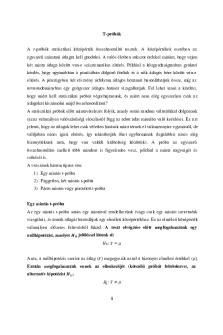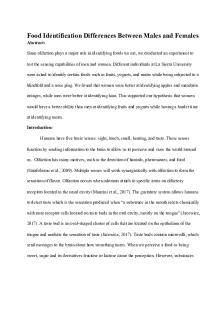Differences 2 T PDF

| Title | Differences 2 T |
|---|---|
| Author | Bhavni Tailor |
| Course | Introductory Research Methods in Psychology |
| Institution | De Montfort University |
| Pages | 2 |
| File Size | 57.9 KB |
| File Type | |
| Total Downloads | 1 |
| Total Views | 141 |
Summary
differences t-tests lecture notes and additional information ...
Description
DIFFERENCES 2 T-TEST When interpreting SPSS’s t test output, it allows you to do two things: 1) Descriptives 2) Inferentials Independent samples T-test Compares scores from two different sets of participants – Participants A and Participants B It is always a between participant design Parametric and a natural distribution using T-test These are descriptives which tell us the groups mean and standard deviation. N represents the number of people You can then carry out a levene’s test which looks at the mean in more depth to decide whether there has been significant difference.
Paired samples T-test Compares two different scores from one set of participants – Participant A with score 1 and 2 Always a within participant design Parametric and a natural distribution using T-test First, the descriptives would give an idea of how many people there are, the mean and standard deviation. The paired samples T-test does not require a levene’s test as variabilities are not compared only the difference scores. Mean represents central tendency of the difference scores Standard deviation represents variability of the difference scores The t-test assesses whether the two conditions means differ significantly i.e. in the population Sig < .05 significant difference in the means (2 tailed) Sig > .05 non-significant difference in the means
Standard Error of the mean(SEM): Provides estimate of the variability in the means of different samples. Standard deviations of the sample means Computer based on the sample standard deviation and sample size Confidence interval of the mean(Cl): Provides range of scores that is likely to include the population mean 95% of cl of mean is estimated to include the population mean 95% of the time across different samples
DIFFERENCES 3: NON PARAMETRIC Non parametric: no distributional requirements/ assumptions Ranking: Ordering the scores from lowest to highest with a number given a ranking of 1 to label it. Variables: suitable for ordinal, interval and ratio data Mann Whitney U test and Wilcoxon matched pairs test: Compare the ranks of two sets of scores Mann Whitney U-test: compares scores from two different sets of participants (independent samples and between participant design) U statistic is computed based on the ranks: scores are ranked ignoring group and summed separately for each groups.
U test assesses whether the two conditions differ significantly i.e. in the population Asymp. Sig < .05 significant difference in the ranks (2-tailed) Asymp. Sig > 0.05 non-significant difference in the ranks (2-tailed)
Wilcoxon matched pairs test: compares two different scores from one set of participants (paired samples and within participant design). Difference score: computed for each participant as their score in one group or condition minus their score in the other T statistic(T): computed based on the ranks of the difference scores The difference scores are ranked ignoring positive and negative They are then summed separately for positive vs negative scores The T stat equals the smaller of the sums...
Similar Free PDFs

Differences 2 T
- 2 Pages

Apuntes manual t-1 y t-2
- 20 Pages

T. 2 - Apuntes 1
- 13 Pages

T.2 CJI
- 20 Pages

T groups - t group
- 3 Pages

Tabla t student 2 colas
- 2 Pages

T-próba - t-próba
- 15 Pages

Resumen T 1 y 2
- 4 Pages

Calidad 2-1 moodle - Apunts t-2
- 59 Pages

T.2 U - Lecture notes 2
- 4 Pages

Gender differences in senses
- 11 Pages

Cadbury vs. Mars differences
- 2 Pages
Popular Institutions
- Tinajero National High School - Annex
- Politeknik Caltex Riau
- Yokohama City University
- SGT University
- University of Al-Qadisiyah
- Divine Word College of Vigan
- Techniek College Rotterdam
- Universidade de Santiago
- Universiti Teknologi MARA Cawangan Johor Kampus Pasir Gudang
- Poltekkes Kemenkes Yogyakarta
- Baguio City National High School
- Colegio san marcos
- preparatoria uno
- Centro de Bachillerato Tecnológico Industrial y de Servicios No. 107
- Dalian Maritime University
- Quang Trung Secondary School
- Colegio Tecnológico en Informática
- Corporación Regional de Educación Superior
- Grupo CEDVA
- Dar Al Uloom University
- Centro de Estudios Preuniversitarios de la Universidad Nacional de Ingeniería
- 上智大学
- Aakash International School, Nuna Majara
- San Felipe Neri Catholic School
- Kang Chiao International School - New Taipei City
- Misamis Occidental National High School
- Institución Educativa Escuela Normal Juan Ladrilleros
- Kolehiyo ng Pantukan
- Batanes State College
- Instituto Continental
- Sekolah Menengah Kejuruan Kesehatan Kaltara (Tarakan)
- Colegio de La Inmaculada Concepcion - Cebu



